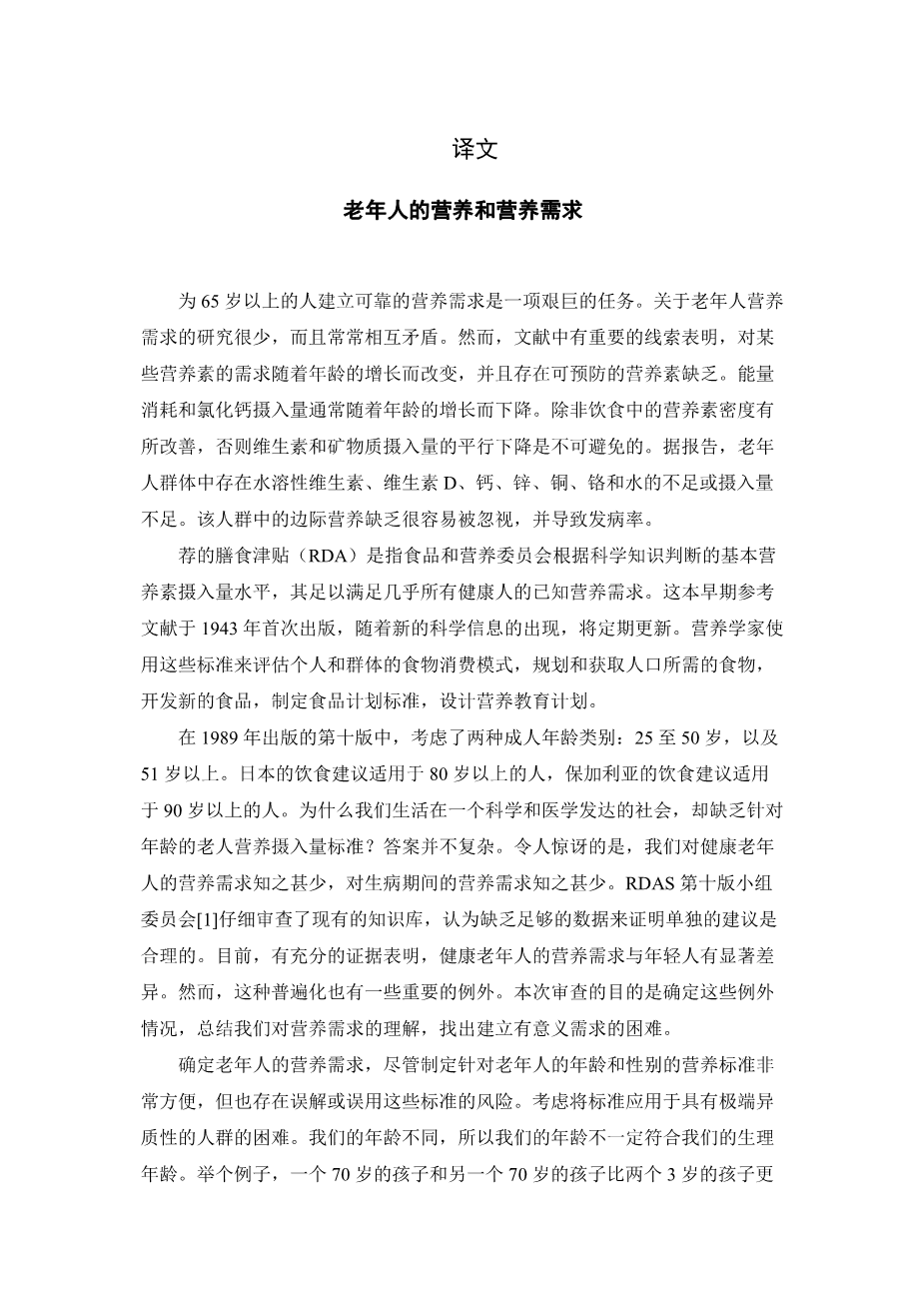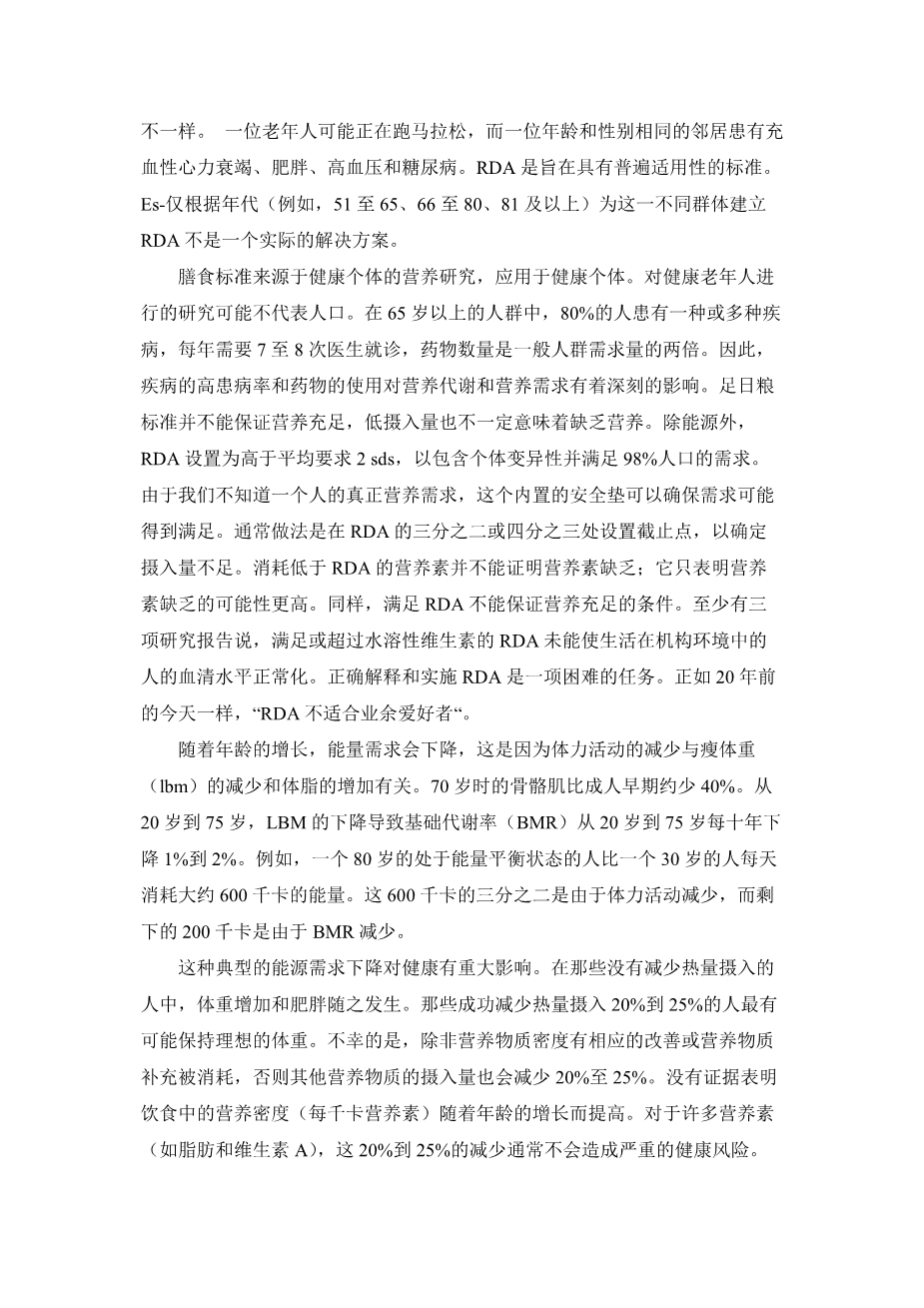Nutrition and Nutritional Requirements for the Older Adult
Jane E. Kerstetter, Ph.D., R.D., 1 Beth A. Holthausen, M.S., R.D., 2 and Polly A. Fitz, M.A., R.D. ~University of Connecticut, School of Allied Health Professions, Storrs, Connecticut, and 2Department of Veterans Affairs Medical Center, Dayton, Ohio, USA
Abstract.
Establishing reliable nutrient requirements for individuals over the age of 65 years is a difficult task. Research on nutrient requirements in the aged is sparse and often contradictory. However, there are important clues in the literature suggesting that requirements for certain nutrients are altered with age and that preventable nutrient deficiencies exist. Energy
expenditure and ca- loric intake typically decline with age. Unless nutrient density of the diet improves, a parallel decline in vitamin and mineral intake is inevitable. Deficiencies or subopti- mal intakes of water-soluble vitamins, vitamin D, cal- cium, zinc, copper, chromium, and water are reported in groups of older adults. Marginal nutrient deficiencies in this population may easily go undetected and contribute to morbidity.
Key words:
Nutrition -- Nutrient requirements -- Eld- erly -- Aged -- Geriatric -- Deglutition -- Deglutition disorders.
Recommended dietary_allowances (RDAs) are defined as the levels of intake of essential nutrients that, based on scientific knowledge, are judged by the Food and Nutri- tion Board to be adequate to meet the known nutrient needs of practically all healthy persons [1]. First printed in 1943, this early reference is updated periodically as new scientific information becomes available. Nutrition- ists use these standards to evaluate food consumption patterns of individuals and groups, plan and obtain foods for populations, develop new food products, establish standards for food programs, and design nutrition educa- tion programs [ 1 ].
The tenth edition, published in 1989, considers two age categories for adults: 25 to 50, and above 51 years. Japanese dietary recommendations exist for those over 80 years, while Bulgaria has recommendations for those over 90 years [2]. Why is it that we live in a scientifically and medically advanced society yet lack age-specific standards of nutrient intake for older per- sons? The answer is not complicated. We know surpris- ingly little about nutrient requirements for the healthy older person and even less about these needs during ill- ness [3]. The Subcommittee on the Tenth Edition of the RDAs [1] carefully reviewed the existing knowledge base and concluded that sufficient data were lacking to justify separate recommendations. Currently, there is lit- tle evidence that nutrient needs for healthy elderly people differ significantly from those of younger adults [4]. There are, however, important exceptions to this general- ization. The purposes of this review are to identify those exceptions, summarize our understanding of nutrient re- quirements, and identify the difficulties in establishing meaningful requirements.
Establishing Nutrient Requirements in the Older Adult
Although it would be quite convenient to have age- and sex-specific nutrition standards for the elderly, there is risk of misunderstanding or misuse of these standards [5]. Consider the difficulty in applying standards to a population characterized by extreme heterogeneity. We age at different rates, so our chronological age does not necessarily correspond to our biological age. For exam- ple, a 70-year-old differs more from another 70-year-old than two 3-year-olds differ from each other. One older person may be running marathons while a neighbor of the same age and gender suffers from congestive heart fail- ure, obesity, hypertension, and diabetes. The RDAs are standards designed to have generalized applicability. Es- tablishing RDAs based on chronological age alone (for example, 51 to 65, 66 to 80, 81 and above) for this diverse group is not a practical resolution. [5].
Dietary standards are derived from nutrition stud- ies on healthy individuals and should be used for healthy individuals. Research conducted in healthy aged persons may not be considered representative of the population. Of those over 65 years, 80% suffer from one or more diseases requiring seven to eight doctor visits annually and twice as many drugs as the general population re- quires [5, 6]. Thus, high prevalence of disease and use of medications profoundly influences nutrient metabolism and, therefore, nutrient requirements.
Meeting the RDAs does not assure nutrient ade- quacy, nor does a low intake necessarily mean a defi- ciency. Except for energy, RDAs are set at 2 SDs above the average requirement to encompass individual vari- ability and meet the needs of 98% of the population (Figure 1). Since we do not know an individuals true nutrient requirement, this built-in safety cushion assures that requirements are probably met. It is common prac- tice to set cut-off points of two-thirds or three-quarters of the RDA to identify inadequate intake levels. Consump- tion of less than the RDA for a nutrient does not prove a deficiency; it only suggests a higher probability for a deficiency. Likewise, meeting the RDA does not assure a nutrient-sufficient condition. There are at least three studies that report that meeting or exceeding the RDA for water-soluble vitamins failed to normalize serum levels in people living in institutional settings [7-9]. Correctly interpreting and implementing the RDAs is a difficult task. . It is as true today as it was 20 years ago that 'the RDAs are not for amateurs' [10].
Fig. 1. The RDA for energy is based on the average energy require- ment for a given population (point A). The RDA for other nutrients are set at 2 SDs above the average requirement in order to cover the needs of 98% of individuals (point B) (adapt
剩余内容已隐藏,支付完成后下载完整资料


英语译文共 6 页,剩余内容已隐藏,支付完成后下载完整资料
资料编号:[610227],资料为PDF文档或Word文档,PDF文档可免费转换为Word


